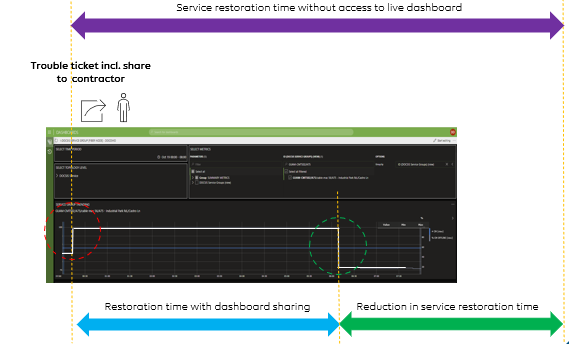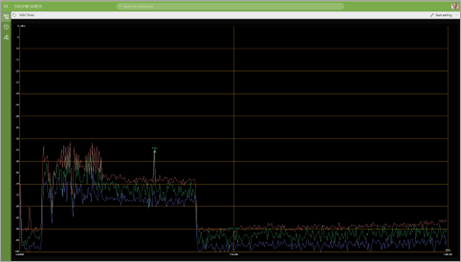example Use Case
Dashboard sharing reducing OPEX while accelerating incident resolution
Cloud

This use case illustrates the benefits of sharing dashboards via the DataMiner Cloud Services in an operational environment. It shows an example where the network operations center (NOC) sees all modems within a specific service group go offline. As part of their standard procedure, they create a ticket for the team or contractor that is responsible for resolving this incident.
USE CASE DETAILS
 Without the dashboard sharing capability, the trouble ticket will see attached an export of a dashboard incl. trend graph that shows how suddenly 100% of the modems has gone offline. This snapshot would then be used by the technician to kick off their intervention to make sure the modem connections are recovered as quickly as possible, so that the services that depend on these can be restored as well. Unfortunately, while working on this incident without access to “real” data, the technician will need to find other ways to confirm if the measures they take effectively result in the modems coming back online. Not only will this negatively affect the time required to resolve the incident, but it will also require further support from the NOC. During the actual troubleshooting process, the NOC will need to confirm if the issue has been addressed, and then when the incident is effectively closed, they will need to deliver a snapshot to confirm this, as a third-party contractor may need this in order to attach it to their invoice and successfully claim their payment.
Without the dashboard sharing capability, the trouble ticket will see attached an export of a dashboard incl. trend graph that shows how suddenly 100% of the modems has gone offline. This snapshot would then be used by the technician to kick off their intervention to make sure the modem connections are recovered as quickly as possible, so that the services that depend on these can be restored as well. Unfortunately, while working on this incident without access to “real” data, the technician will need to find other ways to confirm if the measures they take effectively result in the modems coming back online. Not only will this negatively affect the time required to resolve the incident, but it will also require further support from the NOC. During the actual troubleshooting process, the NOC will need to confirm if the issue has been addressed, and then when the incident is effectively closed, they will need to deliver a snapshot to confirm this, as a third-party contractor may need this in order to attach it to their invoice and successfully claim their payment.
 With DataMiner dashboard sharing, the process is drastically simplified. Attached to the trouble ticket a link to the dashboard has been shared with the team in charge of resolving the incident, they have exactly the same visibility on the incident as the team that generated the ticket. This means that the technician working on the incident can immediately see if a specific action (e.g. restart or replacement) leads to modems coming back online. A third-party contractor will also no longer need to reach out to the operations team to collect “proof” that all modems are back online to make sure their invoice is accepted and paid. This results in incidents getting resolved significantly more quickly without any need for further exchanges between the team that opened the case and the team or contractor in charge of resolving the incident. As a result, operators can enjoy a significant OPEX reduction while their customers will in turn be presented with higher network and service availability.
With DataMiner dashboard sharing, the process is drastically simplified. Attached to the trouble ticket a link to the dashboard has been shared with the team in charge of resolving the incident, they have exactly the same visibility on the incident as the team that generated the ticket. This means that the technician working on the incident can immediately see if a specific action (e.g. restart or replacement) leads to modems coming back online. A third-party contractor will also no longer need to reach out to the operations team to collect “proof” that all modems are back online to make sure their invoice is accepted and paid. This results in incidents getting resolved significantly more quickly without any need for further exchanges between the team that opened the case and the team or contractor in charge of resolving the incident. As a result, operators can enjoy a significant OPEX reduction while their customers will in turn be presented with higher network and service availability.
 DataMiner Dashboards can also contain spectrum information, which can also be shared with anyone both within and outside the company. Imagine that you can access the return spectrum as observed at a node while standing anywhere in the network, by just looking at a shared dashboard. Imagine also having to do without this.
DataMiner Dashboards can also contain spectrum information, which can also be shared with anyone both within and outside the company. Imagine that you can access the return spectrum as observed at a node while standing anywhere in the network, by just looking at a shared dashboard. Imagine also having to do without this.
1 thought on “Dashboard sharing reducing OPEX while accelerating incident resolution”
Leave a Reply
You must be logged in to post a comment.
Wonderful